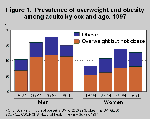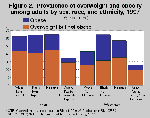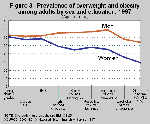Prevalence of Overweight and Obesity Among Adults in the United States
Data from the newly released 1997 National Health Interview Survey show that more than 50% of U.S. adults are overweight and 1 in 5 adults are obese. Overweight and obesity are risk factors for a variety of chronic health conditions, including hypertension and diabetes mellitus. Despite public health efforts to encourage Americans to attain and maintain a healthy weight, the 1997 results suggest that much work remains to be done.
Estimates of overweight and obesity, reported here, are based on definitions provided in the Dietary Guidelines for Americans, published by the U.S. Department of Agriculture and the Department of Health and Human Services. Overweight is defined as a Body Mass Index (BMI) greater than or equal to 25; obesity, a subset of overweight, is defined as a BMI greater than or equal to 30. [Body mass index is a measure of body weight relative to height and is computed as weight/height2, where weight is measured in kilograms and height in meters.]
Over one-half (54.3%) of adults were overweight (BMI greater than or equal to 25) in 1997, as were nearly two-thirds (62.3%) of men and just under one-half (46.6%) of women (Table 1 [PDF - 10 KB]). Almost 1 in 5 adults (18.8% of men and 19.3% of women) were obese. Overweight increased steadily with age, peaking in the age group 45-64 years, and declining somewhat thereafter (table 1 and figure 1). Among persons ages 45-64 years, the prevalence of overweight was 70.7% for men and 55% for women. Nearly one-quarter of both men (23%) and women (24.6%) in this age group were obese.
Racial and ethnic differences in the prevalence of overweight were also found, particularly for women (Table 1 [PDF - 10 KB] and figure 2). Black women had the highest prevalence of overweight (64.5%), followed by Hispanic women (56.8%), white women (43%) and Asian/Pacific Islander women (25.2%). Further, black women (33.2%) were nearly twice as likely as white women (17.3%) and more than 5 times as likely as Asian/Pacific Islander women (5.9%) to be obese. Among men, estimates of overweight were about the same for the three largest population subgroups: Hispanic (64.7%); white, non-Hispanic (62.4%); and black, non-Hispanic (64.1%). Only Asian/Pacific Islander men had significantly lower rates of overweight (35.2%) than each of the other three groups.
The prevalence of overweight and obesity were also related to level of educational attainment among U.S. adults, especially among women. The prevalence of overweight ranged from approximately 60% among women who had not finished high school, 49% of high school graduates, down to about 29% of women who had earned post-graduate college degrees (Table 1 [PDF - 10 KB] and figure 3). In contrast, among men, the prevalence of overweight remained high (and even increased) at all levels of education, dropping noticeably only among men who had attained college degrees. Even then, prevalence was still well over 50%. These statistics were age-adjusted, thereby eliminating age as an explanation for the observed differences.
The National Health Interview Survey (NHIS) is a survey of the noninstitutionalized civilian population, conducted continuously throughout each year. The survey has been conducted since 1957 and underwent a major redesign of its questionnaire and of its data capture instrument in 1997. These findings are the first published from the new design. Height and weight were self-reported. For further information go to the NHIS home page.
Prevalence of Sedentary Leisure-time Behavior Among Adults
- Page last reviewed: November 6, 2015
- Page last updated: February 3, 2010
- Content source:


 ShareCompartir
ShareCompartir


